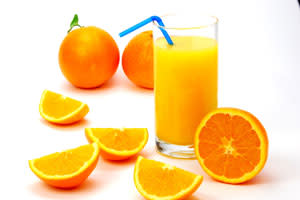 Yahoo Lifestyle
Yahoo LifestyleThe secrets behind how orange juice is really made

Thought your carton of ‘not from concentrate’ orange juice was unprocessed? Think again. A surprising amount of manipulation actually goes into making it.
Alissa Hamilton, author of the book Squeezed, reveals what goes on behind the scenes to create commercially-produced ‘not from concentrate’ orange juice.
The juicing process
According to Tropicana’s website, their oranges are monitored during growth and picked at their “peak of goodness and flavour”. The fruit is then taken to a juice making plant before being graded. Any inferior oranges are removed, and the fruit is washed. The orange oil is then extracted from the peel of the fruit, so that it can be added to the juice later to enhance flavour, and then finally the oranges are squeezed.
[See also:The biggest breakfast cereal offenders]
Pasteurisation
Once squeezed, the juice is pasteurised (rapidly heated) to free it of any bacteria and make it safe to drink. Tropicana say they have developed a technique that minimises the period of time the juice is heated – called ‘flash pasteurisation’, which they say provides the juice with “maximum nutrition and flavour”. Alissa agrees that pasteurisation has no effect on the flavour of the juice.
Preserving the juice
While Alissa was researching for her book, she found that after pasteurisation, companies were storing the juice in “huge, million-gallon aseptic tanks.” The juice was then stripped of oxygen to preserve it. However, according to Alissa, this process has a detrimental effect on flavour. She explains: “When you strip oxygen from the juice you also strip it of the natural flavour”, adding that the resulting liquid, if left alone, “would taste like sugared water”. So after this process, flavour is added back in to the juice to make it good for drinking.
The flavour
But which flavours are added? Alissa explains that flavour and fragrance companies (the same organisations that make high-end perfume) can be hired by companies to make ‘flavour packs’ derived from the natural oils and essences found in the orange. “Flavour companies break down the oils into different chemicals,” she explains - which are then blended and added back to the juice to create each brand’s “signature flavour”. And, as some nations prefer their orange juice sweeter, sharper or more intense than others, she says these flavour packs can be carefully blended to cater for different preferences around the world. What’s more, because they are derived from oranges, they do not need to be legally declared on the label.
The colour
Alissa is quick to emphasise that it is illegal to add anything artificial – including colourants – to the orange juice and not declare it on the packaging. But, she does tell us that companies have a trick up their sleeve to make sure the orange juice has that attractive, vibrant colour that consumers expect. “They are allowed to add a certain percentage of tangerine juice to orange juice to give that colour”, she explains.
Blending
Remember the aseptic tanks? Well not all of the juice stored in them is used straight away. According to Alissa, some juice is kept back from each batch, and can stay in storage for around a year. This older juice is then added to new batches to maintain a consistent taste that customers recognise. Once blended, the resulting juice is then packaged and distributed, before ending up on your breakfast table.
Surprising uses for everyday ingredients
What does 2000 calories a day look like?
Five nutritious breakfasts

